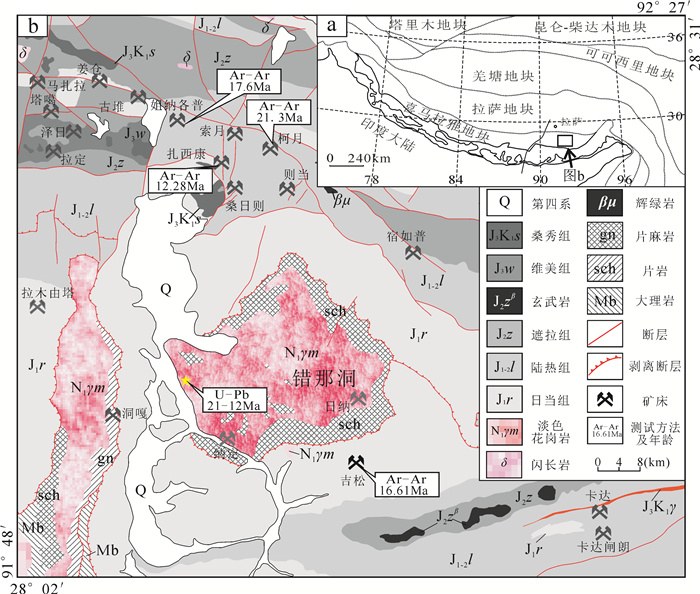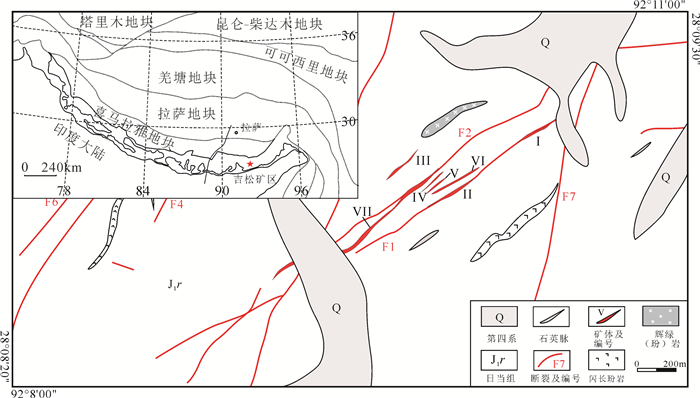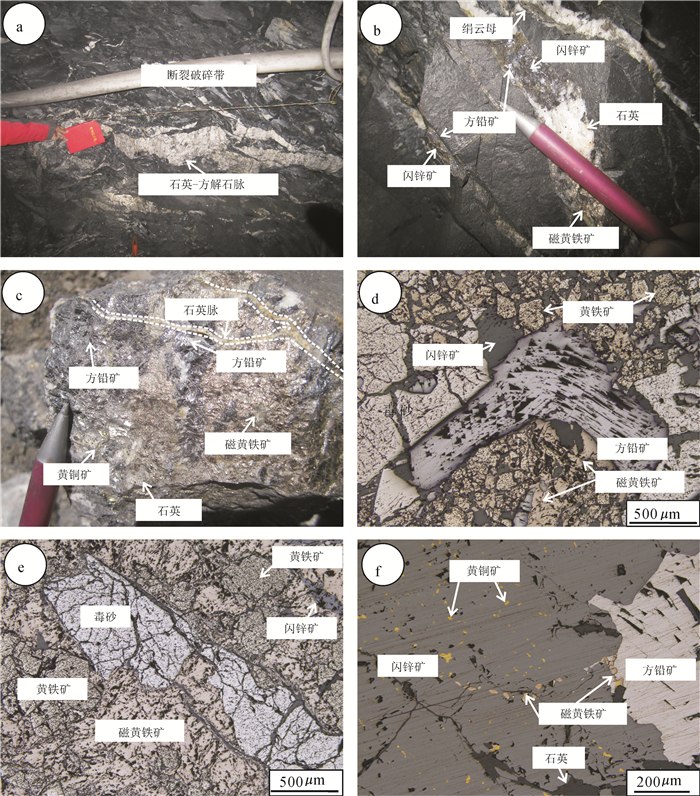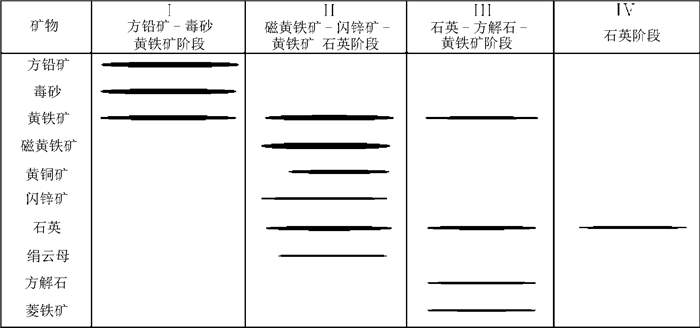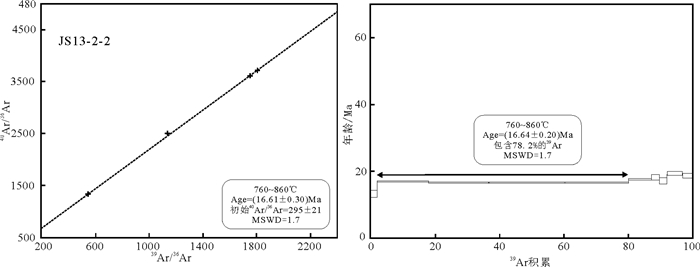-
摘要:
吉松脉状铅锌多金属矿位于特提斯喜马拉雅东段中部,是该带内新近发现的铅锌矿床。吉松铅锌矿矿脉产于数条北东向断裂之中,以石英-方解石-硫化物脉形式充填断裂破碎带。本文采用Ar-Ar同位素年代学方法对石英-硫化物脉中的绢云母进行了测试分析,在760~860℃温度区间获得绢云母的坪年龄为(16.61±0.30)Ma,对应的等时线年龄为(16.64±0.30)Ma。两组年龄在误差范围内相等,能够代表绢云母的形成时间。该Ar-Ar年龄指示了吉松铅锌矿形成于17 Ma左右。特提斯喜马拉雅成矿带在主碰撞成矿阶段发育一期金(银)矿化事件(59~49 Ma),而以吉松为代表的铅锌矿化事件则集中于后碰撞阶段(21~12 Ma)。由于吉松铅锌矿与错那洞淡色花岗岩体密切的时空关系,结合二者相似的铅同位素关系,暗示错那洞淡色花岗岩为吉松铅锌成矿提供了物源和热驱动力。
Abstract:The Jisong Pb-Zn deposit is one of the newly found deposits in the Tethys Himalaya belt. Orebodies mainly occur as veins in several nearly NE-striking faults. The veins are mainly composed of quartz, calcite, and sulfides. Hydrothermal sericite is genetically associated with zinc and lead mineralization and coexists with quartz, calcite, pyrite, sphalerite and galena. These sericite grains were separated for Ar-Ar isotopes dating. The results yielded a plateau age of (16.61±0.30) Ma at 760-860℃, with the corresponding isochron age being (16.64±0.30) Ma. These two ages are the same within the error, indicating that they can represent the formation age of the Jisong Pb-Zn deposit. Tethys Himalaya developed an Au (Ag) mineralization event in the main collisional orogenic setting, and the Ar-Ar age of the Jisong deposit indicates that Pb-Zn mineralization represented by Jisong in South Tibet occurred at late collisional stage. Combined with close spatial relationships as well as the similarities in time and Pb isotopes between the Jisong deposit and the Cuonadong leucogranite, the authors hold that the leucogranite possibly offered material and heat to the Jisong ore-forming hydrothermal system.
-
Keywords:
- Tethyan Himalaya /
- Jisong /
- Ar-Ar dating /
- South Tibet /
- Pb-Zn deposit
-
1. 引言
西南“三江”构造带位于喜马拉雅—特提斯构造域东部,是环太平洋造山带与特提斯造山带的结合部,古欧亚大陆与冈瓦纳大陆的碰撞汇聚地带(图 1a),具有独特的构造条件和相对完整的特提斯演化历程。一直以来备受中外地质研究者的青睐,成为研究特提斯演化的首选之地(黄汲清和陈炳蔚,1987;张旗等,1996;潘桂棠等,1997;沈上越等,2002; 李峰等,2010)。南澜沧江构造火山岩带是西南“三江”构造火山岩带的重要组成部分,从而成为研究特提斯构造演化的重要窗口。因此,该地区岩浆岩的研究,对建立区域岩浆作用的时空架构,探讨南澜沧江构造火山岩带,乃至整个“三江”地区的构造演化历程均具有重要意义(朱勤文等, 1991, 1998, 1999;张虎,2005)。自20世纪末和21世纪初莫宣学(1998)、朱勤文(1991, 1998, 1999)、彭头平(2006)等对三江地区火山岩工作相对薄弱区做了进一步研究,主要以南澜沧江带北段到中段的二叠—三叠纪火山岩和云县一带的火山岩等为重点,从年代学、岩石学特征、地球化学特征、构造环境及物质来源等方面进行研究。对于澜沧江南带火山岩系的研究,前人较为集中的观点是:昌宁—孟连蛇绿混杂岩带代表了古特提斯主支——澜沧江洋的残迹,而澜沧江南带火山岩系正是与其相对应的火山弧,是澜沧江洋向东俯冲消减的产物(李达周等,1986;刘本培等,1993;从柏林等,1993;方宗杰等, 1990, 1992)。
![]() 图 1 大地构造简图(a)、滇西三江地区中生代火成岩分布图(b)、调查区地质简图及采样位置图(c)1—花开左组; 2—芒汇河组二段; 3—芒汇河组一段; 4—小定西组; 5—下坡头租; 6—大凹子组; 7—龙洞河组; 8—团梁子组; 9—变质带; 10—花岗岩; 11—T2火山岩; 12—T3火山岩; 13—块体间大型逆冲断裂带; 14—拉张盆地内的正断层; 15—块体旋转方向; 16—断裂带; 17—断层; 18—角度不整合; 19—平行不整合; 20—澜沧江; 21—剖面位置; 22-采样位置及编号Figure 1. The tectonic location (a), Mesozoic igneous rock distribution in Sanjiang area, western Yunnan (b), simplified geological map and sampling position (c)1-Huakaizuo Group; 2-Manghuihe Group second member; 3-Manghuihe Group first member; 4-Xiaodingxi Group; 5-Xiapotou Group; 6-Dawazi Group; 7-Longdonghe Group; 8-Tuanliangzi Group; 9-Metamorphic zone; 10-granite; 11-T2 Volcanic rock; 12-T3 Volcanic rock; 13-Large thrust fault zone between blocks; 14-Normal faults in tensioned basins; 15-Block rotation direction; 16-Fault zone; 17-Fault; 18-Angular misalignment; 19-Parallel unconformity; 20-Lancang River; 21-Profile position; 22-Sampling position and number
图 1 大地构造简图(a)、滇西三江地区中生代火成岩分布图(b)、调查区地质简图及采样位置图(c)1—花开左组; 2—芒汇河组二段; 3—芒汇河组一段; 4—小定西组; 5—下坡头租; 6—大凹子组; 7—龙洞河组; 8—团梁子组; 9—变质带; 10—花岗岩; 11—T2火山岩; 12—T3火山岩; 13—块体间大型逆冲断裂带; 14—拉张盆地内的正断层; 15—块体旋转方向; 16—断裂带; 17—断层; 18—角度不整合; 19—平行不整合; 20—澜沧江; 21—剖面位置; 22-采样位置及编号Figure 1. The tectonic location (a), Mesozoic igneous rock distribution in Sanjiang area, western Yunnan (b), simplified geological map and sampling position (c)1-Huakaizuo Group; 2-Manghuihe Group second member; 3-Manghuihe Group first member; 4-Xiaodingxi Group; 5-Xiapotou Group; 6-Dawazi Group; 7-Longdonghe Group; 8-Tuanliangzi Group; 9-Metamorphic zone; 10-granite; 11-T2 Volcanic rock; 12-T3 Volcanic rock; 13-Large thrust fault zone between blocks; 14-Normal faults in tensioned basins; 15-Block rotation direction; 16-Fault zone; 17-Fault; 18-Angular misalignment; 19-Parallel unconformity; 20-Lancang River; 21-Profile position; 22-Sampling position and number云南省地质矿产局在编著《云南省岩石地层》 (1996年)笼统地将澜沧江带的三叠系火山岩进行了归并,以酸性岩为主的一套火山岩划为中三叠统忙怀组,以中基性火山岩为主的一套火山岩划为上三叠统小定西组。21世纪初前人在研究区北部1:5万那许、弯手寨等幅区域调查中将酒房断裂以西出露的芒汇河组地层按沉积-喷发韵律划分为二段:一段为浅灰、灰白、紫红色中厚层状复成分(砂)砾岩、石英质砾岩、细砾岩、长石石英砂岩;岩石中含介形类Darwinula- Metacypris组合带、叶肢介Palaeolimnadia组合带、Euestheria minuta带及双壳类Modiolus-Mytilus-Pseudocorbula组合带(?)主要分子,将年代地层暂定为上三叠统瑞替阶,但不排除已进入下侏罗统的可能❶;二段为浅灰紫、紫红色流纹岩、流纹英安岩及火山角砾岩,以喷发不整合覆于芒汇河组一段灰白色石英质细砾岩、灰红色砂岩之上,与上覆中侏罗统花开左组(J2h)呈假整合接触。随着区调工作的进一步开展,研究人员对该区域芒汇河组火山岩提出了新的时代认识:该区域芒汇河组火山岩系为早期弧火山岩浆在侏罗纪红盆形成早期拉张作用下喷发的产物,并且横向上岩性、厚度变化较大。虽然前人对南澜沧江构造火山岩带做过较多年代学、岩石学、岩石地球化学工作,但针对芒汇河组火山岩的相关研究相对较为缺乏。为此,笔者在1:5万区域地质调查的基础上,对普洱市江桥—那澜一带芒汇河组火山岩的岩石学、同位素年代学、岩石地球化学等进行了深入的分析研究,在此基础上对该火山岩的成因、物源、构造环境等特征进行探讨,为建立南澜沧江地区造山活动的完整时空格架提供新的依据,进而为印支构造旋回在该区域的演化过程提供相应的时间约束。
2. 区域地质背景及岩石学特征
研究区位于昌宁—孟连褶皱带和思茅地块两个大地构造单元结合部(云南省区域地质志,1990),即临沧花岗岩基以东,兰坪—思茅中生代红层盆地以西的南澜沧江构造火山岩带(图 1b)。区内构造复杂,出露最老地层为中元古界团梁子岩组,岩性主要为灰绿、灰色(石英)绢云千枚岩、绢云石英千枚岩,中部夹绿泥绢云千枚岩、绿泥石英钠长千枚岩,上部夹阳起绿泥绿帘千枚岩、钠长绿泥绿帘千枚岩;该岩组岩石变形强烈,发育三期面理。古生界大凹子组二段(DCd2),龙洞河组(CPl),中生界下坡头组(T2x),大水井山组(T2d),芒汇河组(J1mh),花开左组(J2h)等。区内的断裂构造主要为NW—近NS,少有东西或近东西向断层,其均为南澜沧江构造的次级构造。
芒汇河组火山岩在澜沧江构造带南段横向上岩性、厚度变化较大,由就康向北、向南英安岩迅速变薄、甚至尖灭,在北侧文乃、南侧永平为一套中基性火山碎屑岩、中基性熔岩夹少量中酸性岩、(凝灰质)砾岩、岩屑砂岩、(凝灰质)泥岩;岔河—崴里一带,以浅灰、灰白、紫红色英安岩、英安质火山角砾岩、英安质集块岩为主,次为紫红、灰绿、紫色安山岩、安山质集块岩、安山质火山角砾岩及少量玄武岩、中基性凝灰岩、紫红色泥岩,其中的英安岩、英安质火山碎屑岩主要集中于上部。
本文的研究对象为分布于滇西普洱市江桥一带澜沧江两岸的芒汇河组(J1mh)二段火山岩。该套火山岩具斑状结构,基质具玻璃质结构,流纹构造斑晶主要有半自形板柱状斜长石(10%~15%)、他形粒状钾长石(5%~10%)、少量蚀变角闪石、石英等,不均匀分布。基质主要由玻璃质(45%~50%)和微粒状长英质(30%~35%)相间呈条纹围绕斑晶构成典型的流纹构造,应为流纹岩与英安岩的过渡类型。本文在岩矿鉴定的基础上结合野外露头(图 2)及地球化学特征将其定名为流纹岩。
![]() 图 2 江桥地区流纹岩野外照片及剖面示意图1—平行不整合; 2—角度不整合; 3—绢云千枚岩; 4—泥质粉砂岩; 5—粉砂质泥岩; 6—杂砂岩; 7—石英细粒岩; 8—流纹岩; 9—英安质流纹岩; 10—气孔杏仁; 11—年代样品位置及标号; 12—采样位置Figure 2. Field photo and geological schematic section for rhyolite in Jiangqiao area1-Parallel unconformity; 2-Angular misalignment; 3-Serenite phyllite; 4- Argillaceous siltstone; 5-Silty mudstone; 6- Graywacke; 7-Quartz fine-grained rock; 8- Rhyolite; 9-Dacite rhyolite; 10- Stomata; 11-Age sample position and label; 12-Sampling position
图 2 江桥地区流纹岩野外照片及剖面示意图1—平行不整合; 2—角度不整合; 3—绢云千枚岩; 4—泥质粉砂岩; 5—粉砂质泥岩; 6—杂砂岩; 7—石英细粒岩; 8—流纹岩; 9—英安质流纹岩; 10—气孔杏仁; 11—年代样品位置及标号; 12—采样位置Figure 2. Field photo and geological schematic section for rhyolite in Jiangqiao area1-Parallel unconformity; 2-Angular misalignment; 3-Serenite phyllite; 4- Argillaceous siltstone; 5-Silty mudstone; 6- Graywacke; 7-Quartz fine-grained rock; 8- Rhyolite; 9-Dacite rhyolite; 10- Stomata; 11-Age sample position and label; 12-Sampling position3. 样品采集及测试
本次用于锆石U-Pb年代学测试的2件样品分别采自那澜西约700 m,思(茅)—澜(沧)公路沿线新开挖人工露头,即D1795号样品(图 1c);和江桥北西约2.5 km南爬河芒汇河组(J1mh)二段剖面(图 2),即D1789号样品。岩石类型为新鲜、无风化的流纹岩,具有十分发育的流纹构造,每件约5 kg。用于主量元素、微量元素和稀土元素测定的样品取自出露较全且连续的南爬河芒汇河组二段地层剖面上,共14件样品(图 2)。
样品岩矿薄片鉴定由云南省地质矿产勘查开发局张伟明研究员完成。主量元素测试由云南省国土资源测试中心的分光光度计和原子吸收测试仪测定,微量元素和稀土元素在国土资源部中南矿产资源监督检测中心用电感耦合等离子体质谱仪(ICP-MS)进行测定,测试的相对标准偏差(RSD)一般小于10%。
锆石单矿物挑选由河北省廊坊市诚信地质服务有限公司实验室利用标准技术完成。其分选流程为:经人工破碎、清水淘洗富集,按常规重力和磁选方法分选出锆石,再在双目镜下挑选出无裂隙、无包裹体、透明干净的自行锆石颗粒。将待测样品锆石颗粒置于环氧树脂中制靶,打磨剖光后送中国地质大学地质过程与矿产资源国家重点实验室,进行反射光和透射光照相,阴极发光扫描电镜进行图像分析,检查锆石内部结构。并利用LA-ICP-MS方法进行锆石U-Pb年龄测定,激光束斑直径为32 μm,采用He作为剥蚀物质的载气。锆石年龄采用国际标准锆石91500作为外标标准物质,含量采用NIST SRM610作为外标。锆石测定点的同位素比值、含量计算采用GLITTER程序,用Anderson et al.(2002)方法对普通Pb进行校正,并采用Isoplot程序(Ludwig, 1991)进行锆石加权平均年龄计算及谐和图的绘制。2件样品(编号D1789和D1795)分别获得17个和16个、共计33个有效测试数据。
4. 锆石U-Pb定年结果
目前普遍认为锆石中的Th/U比值可以在一定程度上指示锆石的成因环境,岩浆锆石的Th、U含量较高,且Th/U比一般大于0.4,而变质锆石的Th/ U比值一般小于0.1(简平等,2002;吴元保等,2004)。由测试数据(表 1)可见本样品的锆石U、Th含量较高,D1789样品的Th/U比值为0.71~1.13,D1795样品的Th/U比值在0.62~1.11,两地样品的Th/U比值比较接近,且均大于0.4,具有典型的岩浆锆石特征。
表 1 锆石U-Pb定年测试数据及结果Table 1. The data and results of zircon U-Pb dating
由两地流纹岩样品中的锆石CL图像(图 3)可以看出,该岩相锆石颗粒较小,大多在50 μm左右,呈短柱状或近椭圆形,均发育较清晰的典型岩浆型锆石的振荡环带和扇形分带,无包裹体,可以确定两地样品中的锆石后期改造作用较弱,为单一岩浆成因。所有测点都打在了锆石的韵律环带上,所测年龄能代表火山岩浆冷凝的时间(周剑雄和陈建宇, 2007)。因此,也可以界定该火山岩的时空分布,为厘定该区域地层的时空架构提供准确的时间依据。
在锆石U-Pb年龄谐和图中(图 4),除D1789中两个数据点和D1795中一个数据点偏离谐和曲线外,其他的数据点均落在谐和曲线上及其附近,表明2件样品在后期的构造事件中受到的影响较小,保留下较多的原始地质历史信息。D1789中17个分析点的206Pb/238U年龄变化在221~176 Ma,D1795中15个分析点的206Pb/238U年龄变化在217~176 Ma,两件样品的206Pb/238U年龄的加权平均值分别为(196.7 ± 2.3)Ma(95%置信度,n=15,MSWD=1.7)、(198.1±3.5) Ma(95%置信度,n=14,MSWD=2.2),属于早侏罗世。这进一步证明了南澜沧江火山岩带的岩浆喷发活动可上延至早侏罗世。
5. 地球化学分析结果
5.1 主量元素
本次工作将南爬河芒汇河组二段剖面的14件样品进行主量元素分析(表 2)。芒汇河组流纹岩的SiO2含量为72.12%~73.51%,平均含量为72.53%,略高于中国花岗岩平均值71.63%(黎彤和倪守斌,1997)。Al2O3=13.08% ~14.55%,MgO=0.11% ~ 0.69%,CaO=0.33% ~0.48%,Na2O=2.49% ~5.00%,K2O= 2.74%~5.70%。该火山岩全碱的含量ALK(Na2O + K2O)在7.53% ~9.04%;K2O/Na2O比值为0.55~2.29,平均为1.12, 属富碱性岩石;TiO2含量低,为0.46%~0.38%, 平均0.41%;MgO和CaO含量较低,分别为0.11%~0.69%和0.33%~0.48%,平均为0.22%和0.37%,低于世界花岗岩的平均值0.71%和1.84%;在CIPW标准矿物中刚玉分子含量在0.88% ~2.35%;铝饱和度A/CNK值在1.06~1.31,平均为1.15,大于1.1,属典型的强过铝质岩石,NK/A在0.54~0.66,平均为0.6,表明该岩石属铝和硅过饱和型;具有陆壳重熔型花岗岩的特点。
表 2 江桥地区流纹岩主量元素成分(%)Table 2. Major element (%) content of rhyodacite in Jiangqiao area
在火山岩TAS图解(图 5a)上投点全部落入流纹岩(花岗岩)区域;在SiO2-K2O分类图解上除2个样点落于钙碱性系列区和一个落入钾玄岩系列区域外,其余样点落入高钾钙碱性系列区域,总体上属于高钾钙碱性系列(图 5b)。在主量元素哈克图解上(图 6),芒汇河组流纹岩TiO2、Al2O3、K2O、P2O5的含量与SiO2含量呈负相关,Na2O含量与SiO2含量呈正相关关系。综上所述,芒汇河组流纹岩具有“高硅、富碱、贫镁、强过铝质”的特征。
![]() Figure 5. TAS diagram (after Irbine et al., 1971; Middlemost, 1994) and SiO2-K2O diagram (after Richwood, 1989) for Trhyolite in Jiangqiao area
Figure 5. TAS diagram (after Irbine et al., 1971; Middlemost, 1994) and SiO2-K2O diagram (after Richwood, 1989) for Trhyolite in Jiangqiao area![]() 图 6 江桥地区流纹岩主量元素Harker图解(底图据Harker, 1909)Figure 6. Harker diagrams of major elements for rhyolite in Jiangqiao area (after Harker, 1909)
图 6 江桥地区流纹岩主量元素Harker图解(底图据Harker, 1909)Figure 6. Harker diagrams of major elements for rhyolite in Jiangqiao area (after Harker, 1909)5.2 稀土元素与微量元素
江桥地区流纹岩的稀土元素、微量元素数据如表 3所示。∑REE在103.4×10-6~254.9×10-6,平均为177.6×10-6,稀土元素总量较高,LREE介于80.7×10-6~206.9×10-6,HREE介于18.1×10-6~62.8×10-6,LREE/HREE介于1.44~6.18。(La/Yb)N为3.03~13.5,平均为8.7。岩球粒陨石标准化稀土元素配分模式图(图 7a)呈明显的右倾斜模式,重稀土相对亏损,轻稀土较为富集;轻重稀土分异较为明显,其中重稀土分异较弱(Gd/Yb)N为0.78~1.91,轻稀土之间的分异比较明显(La/Sm)N为2.12~3.95,∑REE/∑HREE=2.98~4.34,重稀土的分馏程度较轻稀土低;δEu在0.36~0.53,平均为0.43,具有中等的Eu负异常,属壳型花岗岩。在原始地幔标准化的微量元素蛛网图(图 7b)上显示,Rb、Th、La、Ce、Zr等大离子亲石元素相对富集,Sr、P、Ti相对亏损,Rb含量为74.2×10-6~189×10-6,Sr为89.8×10-6~145×10-6,Y为11.34×10-6~40.04×10-6,Rb/Sr比值为0.62~1.23,高于中国上地壳平均值(黎彤和倪守斌, 1997)。综上所述,岩石样品富集大离子亲石元素,亏损高场强元素。
表 3 江桥地区流纹岩微量和稀土元素成分(10-6)Table 3. Trace and rare element (10-6) content of rhyodacite in Jiangqiao area
![]() Figure 7. Chondrite-normalized REE patterns (a) (chondrite data after Boynton, 1984) and primitive mantle-normalized multi-element diagrams (b) (primitive mantle data after Sun et al., 1989) for rhyolite in Jiangqiao area
Figure 7. Chondrite-normalized REE patterns (a) (chondrite data after Boynton, 1984) and primitive mantle-normalized multi-element diagrams (b) (primitive mantle data after Sun et al., 1989) for rhyolite in Jiangqiao area6. 讨论
6.1 岩石成因
从火山岩源区分析,与碰撞有关的强过铝质花岗岩源区主要为地壳中的碎屑沉积岩类(如砂岩、泥质岩等)和变质沉积岩类,当CaO/Na2O<0.3时,为泥质岩生成,当CaO/Na2O>0.3时,为砂屑岩、正片麻岩生成。Sylvester(1998)实验岩石学研究也表明地壳中碎屑沉积岩类部分熔融形成偏酸性的过铝质花岗岩类,而强过铝质酸性岩浆岩主要是由泥砂质沉积岩类部分熔融形成的。江桥地区芒汇河组流纹岩样品CaO/Na2O在0.07~0.1均小于0.3,表明该火山岩岩浆源区岩石成分主要为泥质岩。研究表明Al2O3/TiO2比值可以作为源区岩石部分熔融温度的指示剂,当岩石的Al2O3/TiO2比值>100时,源区部分熔融温度<875℃;当岩石的Al2O3/TiO2比值<100时,源区部分熔融温度>875℃。本次研究的14件样品的Al2O3/TiO2比值为29~36,小于100,所以源区部分熔融温度超过875℃。
芒汇河组流纹岩样点在CaO/(MgO+TFeO)- Al2O3/(MgO+TFeO)图上全部落入变泥质岩部分熔融区(图 8),Nb/La在0.33~0.48,平均为0.41,小于1,表明火山岩源区为陆壳物质;另外其特征参数Nb*(0.59 ~ 0.88)、Sr*(0.13 ~ 0.24)、和Ti*(0.13 ~ 0.17)均<1,为负异常,及Zr*(2.72 ~ 3.36)>1,为正异常,同样表明该火山岩为地壳物质不同程度熔融的产物;里特曼指数(σ)值在1.87~2.81,平均2.34,小于3.3,属钙碱性岩。Zr/Y在14.07~ 20.69,平均为16.78;Nb/La在0.33~0.48,平均为0.41,其中Sr、Ba、Ti、P相对亏损的特征表明岩浆经历了斜长石、钛铁矿和磷灰石的分离结晶作用,分异指数DI介于87.28~92.84,平均为91.4,以上特征显示该火山岩起源于下地壳的重融,并且随后发生一系列的分离结晶作用,岩浆演化程度较高。
![]() 图 8 江桥地区流纹岩CaO/(MgO+TFeO)-Al2O3/(MgO+TFeO)图解(底图据Altherr et al., 2000)Figure 8. C/MF-A/MF diagrams for rhyolite in Jiangqiao area (after Altherr et al., 2000)
图 8 江桥地区流纹岩CaO/(MgO+TFeO)-Al2O3/(MgO+TFeO)图解(底图据Altherr et al., 2000)Figure 8. C/MF-A/MF diagrams for rhyolite in Jiangqiao area (after Altherr et al., 2000)6.2 构造环境
前人研究表明强过铝质花岗岩主要形成于后碰撞构造环境下。是在造山作用所引起地壳增厚之后的构造拉张减压过程中,岩石圈伸展引起下地壳升温,底侵地壳部分熔融形成的,与陆-陆碰撞和板块深俯冲作用密切相关(Pearce et al., 1984;Harria et al., 1986;Harris and Inger, 1992;Pearce, 1996;Barbarin, 1999;邓晋福等, 2004;寇林林等, 2009;李峰等, 2010)。在SiO2-Al2O3图解(图 9a)中样品点全部落入后碰撞花岗岩类区域,芒汇河组流纹岩的微量元素和稀土元素表现为富集大离子亲石元素和轻稀土元素,相对亏损高场强元素和重稀土元素,也具后碰撞花岗岩的特征。在(Y + Nb) –Rb图解(图 9b)上,数据点落入后碰撞花岗岩重叠区域内,在R1-R2图上(图 10)数据点除一个点落入造山晚期—晚造山期其他均落入非造山期花岗岩区内,表明该火山岩形成于后碰撞-非造山的构造环境下,即处于造山后的伸展拉张环境下。
![]() IAG—岛弧花岗岩类;CAG—大陆弧花岗岩类;CCG—大陆碰撞花岗岩类;POG—后碰撞花岗岩类;RRG—与裂谷有关的花岗岩类;CEUG—与大陆抬升有关的花岗岩类;S-COLG—同碰撞花岗岩;VAG—火山弧花岗岩;WPG—板内花岗岩;ORG—洋脊花岗岩Figure 9. Major element tectonic setting discrimination diagrams and trace element tectonic environment discrimination diagrams for rhyolite in Jiangqiao area (after Maniar et al., 1989; Pearce, 1996)IAG-Island arc granite; CAG-Continental Arc Granite; CCG-continent collision granite; POG-Post-orogeny granite; RRG-Granitoids related to rifts; CEUG-Granites related to continental uplift; S-COLG-Syn-collisional; VAG-Volcanic arc granite; WPG-Within plate; ORG-Ocean ridge granite
IAG—岛弧花岗岩类;CAG—大陆弧花岗岩类;CCG—大陆碰撞花岗岩类;POG—后碰撞花岗岩类;RRG—与裂谷有关的花岗岩类;CEUG—与大陆抬升有关的花岗岩类;S-COLG—同碰撞花岗岩;VAG—火山弧花岗岩;WPG—板内花岗岩;ORG—洋脊花岗岩Figure 9. Major element tectonic setting discrimination diagrams and trace element tectonic environment discrimination diagrams for rhyolite in Jiangqiao area (after Maniar et al., 1989; Pearce, 1996)IAG-Island arc granite; CAG-Continental Arc Granite; CCG-continent collision granite; POG-Post-orogeny granite; RRG-Granitoids related to rifts; CEUG-Granites related to continental uplift; S-COLG-Syn-collisional; VAG-Volcanic arc granite; WPG-Within plate; ORG-Ocean ridge granite![]() 图 10 江桥地区流纹岩R1-R2构造环境判别图解(据Batchelor et al., 1985)1—地幔分异的花岗岩;2—板块碰撞前花岗岩;3—板块后隆起的花岗岩;4—造山晚期花岗岩;5—非造山期花岗岩;6—同碰撞花岗岩;7—造山后期花岗岩Figure 10. R1-R2 discrimination diagrams showing the tectonic settings of rhyolite in Jiangqiao area (after Batchelor et al., 1985)1-Mantle departure granite; 2-Pre-collision granite; 3-Post-plate uplift granite; 4-Late orogeny granite; 5-Nonorogenic granite; 6- Syn-collision granite; 7-Post-orogeny granite
图 10 江桥地区流纹岩R1-R2构造环境判别图解(据Batchelor et al., 1985)1—地幔分异的花岗岩;2—板块碰撞前花岗岩;3—板块后隆起的花岗岩;4—造山晚期花岗岩;5—非造山期花岗岩;6—同碰撞花岗岩;7—造山后期花岗岩Figure 10. R1-R2 discrimination diagrams showing the tectonic settings of rhyolite in Jiangqiao area (after Batchelor et al., 1985)1-Mantle departure granite; 2-Pre-collision granite; 3-Post-plate uplift granite; 4-Late orogeny granite; 5-Nonorogenic granite; 6- Syn-collision granite; 7-Post-orogeny graniteA型花岗岩的构造环境除早期认为的非造山外,现今大多数已认为还有另一类后造山A型花岗岩(吴元保和郑永飞, 2004;任飞等, 2017)。江桥地区芒汇河组流纹岩的地球化学特征,与后造山A型花岗岩低Al2O3、CaO,高NK/A、TiO2/MgO等特征相似。张旗等认为A型花岗岩是一类富碱、贫水的花岗岩,化学成分上以贫Al、Sr、Eu、Ba、Ti、P为特征,对原岩没有选择,形成于低压条件下,产于地壳伸展减薄的构造背景,是花岗岩中形成深度最浅的(张旗等, 2006, 2010, 2012, 2013;汪洋等, 2013)。依据Sr-Yb花岗岩分类(张旗等,2006),芒汇河组火山岩原岩属于非常低Sr高Yb型花岗岩类,该类型花岗岩具有中等的铕异常和A型花岗岩的特征,可能形成于地壳厚度较小的位置,属低压类型的花岗岩。
区域岩浆研究显示:在早二叠世—早三叠世昌宁—孟连洋关闭和随之的陆陆(弧)碰撞(莫宣学等, 1998;钟大赉, 1998;张彩华等, 2006;邹光富等, 2011;王硕等, 2012),形成一系列俯冲型岩浆岩,如临沧花岗闪长岩270 Ma(俞赛赢, 2007);早—中三叠世发生俯冲板片断裂,导致岩石圈抬升,使该区域普遍缺失早三叠世地层,同时形成一系列中基性—中酸性的岩浆岩,如中三叠世临沧花岗岩,233 ~ 231 Ma和223 ~ 228 Ma(Peng et al., 2013;王舫等, 2014),忙怀组下段安山岩锆石SHRIMP U-Pb年龄(241±4.9) Ma和忙怀组顶部流纹岩锆石SHRIMP U-Pb年龄(231±5) Ma;晚三叠世俯冲作用基本结束,古特提斯洋最终关闭,形成小定西组及相当层位火山岩以及晚三叠世—早侏罗世一碗水组类前陆盆地沉积(彭头平, 2006;张彩华等, 2006),如具有后碰撞特征的云县小定西组火山岩锆石SHRIMP U-Pb年龄(213.5±7.7) Ma。早侏罗世—晚侏罗世,该地区处于后碰撞的伸展构造背景下,形成一系列后碰撞火山岩,如本文所研究的芒汇河组流纹岩和老毛村花岗岩岩体,Rb-Sr同位素年龄(169±5) Ma(廖世勇等, 2014)。同时研究区江桥一带芒汇河组沉积-火山组合也反映了前陆盆地的沉积特征。
以上研究表明,芒汇河组流纹岩的原岩在构造阶段上形成于大洋闭合—挤压造山之后的伸展引张背景下。由西侧昌宁—孟连古特提斯洋盆关闭后碰撞造山环境下,泥质地壳在较浅的地壳厚度及较小的压力环境下经过部分熔融形成的。同时在下伏热地幔中经置换作用而具有了A型花岗岩的特点。揭示了南澜沧江构造带在早侏罗世存在一次重要的从挤压构造环境向伸展构造环境的转换,而芒汇河组二段早侏罗世流纹岩正是形成于地壳伸展减薄的构造背景下,是南澜沧江构造带印支末期构造-岩浆事件的产物,标志着该区域古特提斯洋演化的完成,也指示了印支构造旋回在滇西南澜沧江地区的最终结束。
7. 结论
(1)滇西江桥地区芒汇河组流纹岩锆石U-Pb同位素年龄为196~198 Ma,表明该火山岩形成时代为早侏罗世,而非前人所划分的晚三叠世,填补了该地区侏罗纪地史时期的火山-沉积记录。
(2)滇西江桥地区芒汇河组流纹岩具有A型花岗岩的特征,是南澜沧江构造缝合带进入构造伸展减压环境下泥质岩系地壳部分熔融的产物。
(3)滇西普洱市江桥一带早侏罗世后碰撞岩浆岩的发现,丰富了南澜沧江构造-岩浆带岩浆岩类的同位素年龄资料,为南澜沧江地区古特提斯演化的时空序列及滇西南澜沧江地区印支构造旋回最终结束的时间提供了新的依据,推断印支构造旋回在该地区最终结束的时间可能为早侏罗世。
注释
❶周存会, 熊家镛, 张志斌, 张伟明, 张虎, 曾庆荣. 2000.云南1: 50000那许幅、黄竹林福、弯手寨幅、黄草坝幅区域地质调查报告.
致谢: 衷心感谢中国地质科学院地质研究所氩氩实验室陈文研究员对实验测试提供的帮助。 -
表 1 藏南吉松铅锌矿断裂构造特征
Table 1 Characteristics of fault system of the Jisong Pb-Zn deposit in southern Tibet

表 2 藏南吉松铅锌矿绢云母40Ar−39Ar测年实验结果
Table 2 Sericite 40Ar-39Ar dating data of Zhaxikang Pb-Zn polymetallic deposit, southern Tibet

表 3 特提斯喜马拉雅金锑铅锌成矿带典型矿床成矿年龄
Table 3 ESR age of quartz in deposits of Tethys Himalaya Au-Sb-Pb-Zn metallogenic belt

-
Burchfiel B C. 1992. The South Tibetan detachment system, Himalayan orogen:Extension contemporaneous with and parallel to shortening in a collisional mountain belt[J]. The Geological Society of America Special Paper 269, 1-41. http://gji.oxfordjournals.org/external-ref?access_num=10.1130/SPE269-p1&link_type=DOI
Burg J, Guiraud M, Chen G, Li G C. 1984. Himalayan metamorphism and deformations in the North Himalayan Belt (southern Tibet, China)[J]. Earth and Planetary Science Letters, 69(2):391-400. doi: 10.1016/0012-821X(84)90197-3
Chen Wen, Zhang Yan, Zhang Yueqiao, Jin Guishan, Wang Qingli. 2006. Late Cenozoic episodic uplifting in southeastern part of the Tibetan plateau——evidence from Ar-Ar thermochronology[J]. Acta Petrologica Sinica, 22(4):867-872(in Chinese with English abstract). http://adsabs.harvard.edu/abs/2009gecas..73r1512z
Dong Suiliang, Huang Yong, Li Guangming, Zhang Linkui, Liang Wei, Qing Chengshi, Zhang Zhi, Li Hongliang, Li Yingxu, Cao Huawen. 2017. Geology and mineralization dating of Jienagepu Gold Deposit in Southern Tibet with Implication from Zhaxikang PbZn-Au-Sb metallogenic system[J]. Resources & Industries, 19(5):56-64(in Chinese with English abstract). http://en.cnki.com.cn/Article_en/CJFDTotal-ZIYU201705011.htm
Fu Jiangang, Li Guangmin, Wang Genhou, Huang Yong, Zhang Linkui, Dong Suiliang, Liang Wei. 2017. First field identification of the Cuonadong dome in southern Tibet:Implications for EW extension of the North Himalayan gneiss dome[J]. International Journal of Earth Sciences, 106(5):1581-1596. doi: 10.1007/s00531-016-1368-2
Fu Jiangang, Li Guangming, Wang Genhou, Huang Yong, Zhang Linkui, Dong Suiliang, Liang Wei. 2018. Establishment of the North Himalayan double gneiss domes:Evidence from field identification of the Cuonadong dome, south Tibet[J]. Geology in China, 45(4):783-802(in Chinese with English abstract). http://d.old.wanfangdata.com.cn/Periodical/zgdizhi201804011
Harrison T M, Copeland P, Kidd W, Yin A. 1992. Raising Tibet[J]. Science, 255(5052):1663-1670. doi: 10.1126/science.255.5052.1663
Harrison T M, Lovera O M, Grove M. 1997. New insights into the origin of two contrasting Himalayan granite belts[J]. Geology, 25(10):899-902. doi: 10.1130/0091-7613(1997)025<0899:NIITOO>2.3.CO;2
Hauck M, Nelson K, Brown L, Zhao W, Brown L D, Zhao W, Ross A R. 1998. Crustal structure of the Himalayan orogen at 90 east longitude from Project INDEPTH deep reflection profiles[J]. Tectonics, 17(4):481-500. doi: 10.1029/98TC01314
Hou Zengqian, Mo Xuanxue, Yang Zhiming, Wang Anjian, Pan Guitang, Qu Xiaoming, Nie Fengjun. 2006a. Metallogeneses in the collisional orogen of the the Qinghai-Tibet Plateau:Tectonic setting, tempo-spatial distribution and ore deposit types[J]. Geology in China, 33(2):340-351(in Chinese with English abstract).
Hou Zengqian, Yang Zhusen, Xu Wenyi, Mo Xuanxue, Ding Lin, Gao Yongfei, Dong Fangliu, Li Guangming, Qu Xiaoming, Zhao Zhidan, Jiang Sihong, Meng Xiangjin, Li Zhenqing, Qin Kezhang, Yang Zhiming. 2006b. Metallogenesis in Tibetan collisional orogenic belt:Ⅰ. Mineralization in main collisional orogenic setting[J]. Mineral Deposits, 25(4):337-359(in Chinese with English abstract).
Hou Zengqian, Pan Guitang, Wang Anjian, Mo Xuanxue, Tian Shihong, Sun Xiaoming, Ding Lin, Wang Enquan, Gao Yongfeng, Xie Yuling, Zeng Lingsen, Qin Kezhang, Xu Jifeng, Qu Xiaoming, Yang Zhiming, Yang Zhusen, Fei Hongcai, Meng Xiangjin, Li Zhenqing. 2006c. Metallogenesis in Tibetan collisional orogenic belt:Ⅱ. Mineralization in late-collisional transformation setting[J]. Mineral Deposits, 25(5):521-543(in Chinese with English abstract).
Hou Zengqian, Qu Xiaoming, Yang Zhusen, Meng Xiangjin, Li Zhenqing, Yang Zhiming, Zheng Mianping, Zheng Youye, Nie Fengjun, Gao Yongfei. 2006d. Metallogenesis in Tibetan collisional orogenic belt:Ⅲ. Mineralization in post-collisional extension setting[J]. Mineral Deposits, 25(6):629-651(in Chinese with English abstract).
Hou Z Q, Zheng Y C, Zeng L S, Gao L E, Huang K X, Li W, Li Q Y, Fu Q, Liang W, Sun Q Z. 2012. Eocene-Oligocene granitoids in southern Tibet:Constraints on crustal anatexis and tectonic evolution of the Himalayan orogen[J]. Earth and Planetary Sciences Letters, 349:38-52. http://www.sciencedirect.com/science/article/pii/S0012821X12003147
Hu Guyue, Zeng Lingsen, Qi Xuexiang, Hou Kejun, Gao Li'E. 2011. The Mid-Eocene subvolcanic field in the Lhunze-Qiaga area, Tethyan Himalaya, southern Tibet:A high-level magmatic suite related to the Yardio two-mica granite[J]. Acta Petrologica Sinica, 27(11):3308-3318(in Chinese with English abstract). http://d.old.wanfangdata.com.cn/Periodical/ysxb98201111012
Huang Chunmei, Zhao Zhidan, Zhu Dicheng, Liu Dong, Huang Yu, Dong Mingchun, Hu Zhaochu, Zheng Jianping. 2013. Geochemistry, zircon U-Pb chronology and Hf isotope Luozha leucogranite, southern Tibet:Implication for petrogenesis[J]. Acta Petrologica Sinica, 29(11):3689-3702 (in Chinese with English abstract). http://d.old.wanfangdata.com.cn/Periodical/ysxb98201311004
Jiang Sihong, Nie Fengjun, Liu Yifei, Bai Dapeng. 2008.contrast of two-stage orogenic gold deposit[J]. Acta Mineralogica Sinica, (1):174-175(in Chinese).
Jiang S H, Nie F J, Hu P, Lai X R, Liu Y F. 2009. Mayum:An orogenic gold deposit in Tibet, China[J]. Ore Geology Reviews, 36:160-1731. doi: 10.1016/j.oregeorev.2009.03.006
Lee J, Hacker B, Wang Y. 2004. Evolution of North Himalayan gneiss domes:Structural and metamorphic studies in Mabja Dome, southern Tibet[J]. Journal of Structural Geology, 26(12):2297-2316. doi: 10.1016/j.jsg.2004.02.013
Lee J, Hacker B R, Dinklage W S, Wang Yu, Gans P, Calvert A, Wang Jinglin, Chen Wenji, Blythe A E, McClelland W. 2000. Evolution of the Kangmar Dome, southern Tibet:Structural, petrologic, and thermochronologic constraints[J]. Tectonics, 19(5):872-895. doi: 10.1029/1999TC001147
Li Guangming, Zhang Linkui, Jiao Yanjie, Xia Xiangbiao, Dong Suiliang, Fu Jiangang, Liang Wei, Zhang Zhi, Wu Jianyang, Dong Lei, Huang Yong. 2017. First Discovery and implications of Cuonadong superlarge Be-W-Sn polymetallic deposit in Himalayan metallogenic belt, southern Tibet[J]. Mineral Deposits, 36(4):1003-1008(in Chinese with English abstract). http://www.wanfangdata.com.cn/details/detail.do?_type=perio&id=kcdz201704014
Liang Wei, Hou Zengqian, Yang Zhusen, Li Zhenqing, Liu Yingchao, Li Qiuyun, Sun Qingzhong, Fu Qiang. 2014. Multiphase and polystage metallogenic process of the Zhaxikang large-size PbZn-Ag-Sb polymetallic deposit in southern Tibet and its implications[J]. Acta Petrologica et Mineralogica, 33(1):64-78(in Chinese with English abstract).
Liang W, Hou Z Q, Zheng Y C, Yang Z S, Li Z Q. 2018. The Zhaxikang Vein-type Pb-Zn-Ag-Sb deposit in Himalayan Orogen, Tibet:Product by overprinting and remobilization processes during post-collisional period[J]. Acta Geologica Sinica(English Edition), 92(2):262-285. http://d.old.wanfangdata.com.cn/Periodical/dzxb-e201802015
Liang Wei, Yang Zhusen, Zheng Yuanchuan. 2015. The Zhaxikang PbZn polymetallic deposit:Ar-Ar age of sericite and its metallogenic significance[J]. Acta Geologica Sinica, 89(3):560-568 (in Chinese with English abstract). http://en.cnki.com.cn/Article_en/CJFDTotal-DZXE201503010.htm
Lin Bin, Tang Juxing, Zheng Wenbao, Wang Yiyun, Gao Yiming, Lin Xin, Yang Huanhuan, Leng Qiufeng, Li Xiaotong, Tang Xiaoqian, Fu Yangang. 2016a. A preliminary study of geological features and metallogenic epoch in Keyue Zn-polymetallic deposit, Tibet[J]. Mineral Deposits, 31(1):33-50(in Chinese with English abstract). http://www.wanfangdata.com.cn/details/detail.do?_type=perio&id=kcdz201601003
Lin Bin, Tang Juxing, Zheng Wenbao, Wang Yiyun, Meng Zhan, Tang Pan, Ding Shuai, Xu Yunfeng, Yuan Mei. 2016b. Geochemical characteristics, age and genesis of Cuonadong leucogranite, Tibet[J]. Acta Petrologica et Mineralogica, 35(3):391-406(in Chinese with English abstract). http://www.wanfangdata.com.cn/details/detail.do?_type=perio&id=yskwxzz201603002
Liu Wenchan, Wang Yu, Zhang Xiangxin, Li Huimin, Zhou Zhiguang, and Zhao XingguoG. 2004. The rock types and isotope dating of the Kangmar gneissic dome in southern Tibet[J]. Earth Science Frontiers, 11(4):491-501(in Chinese with English abstract). http://www.wanfangdata.com.cn/details/detail.do?_type=perio&id=dxqy200404015
Meng Xiangjin, Yang Zhusen, Qi Xuexiang, Hou Zengqian, Li Zhenqing. 2008. Silicon-oxygen-hydrogen isotopic comositions of Zaxikang antimony polymetallic deposit in southern Tibet and its responses to the ore-controlling structure[J]. Acta Petrologica Sinica, 24(7):1649-1655 (in Chinese with English abstract). http://d.old.wanfangdata.com.cn/Periodical_ysxb98200807021.aspx
Nie Fengjun, Hu Peng, Jiang Sihong, Li Zhenqing, Liu Yan, Zhou Yongzhang. 2005. Types and temporal-spacial distribution of gold and antimony deposit(prospects) in Southern Tibet, China[J]. Acta Geologica Sinica, 79(3):373-385(in Chinese with English abstract). http://en.cnki.com.cn/article_en/cjfdtotal-dzxe200503016.htm
Pei Y R, Sun Q Z, Zheng Y C, Yang Z S, Li W, Huang K X. 2016. Genesis of the Bangbu orogenic gold deposit, Tibet:Evidence from fluid inclusion, stable isotopes, and Ar-Ar Geochronology[J]. Acta Geologica Sinica, 90(2):722-737. doi: 10.1111/acgs.2016.90.issue-2
Qi X X, Li T F, Meng X J, and Yu C L. 2008. Cenozoic tectonic evolution of the Tethyan Himalayan foreland fault-fold belt in southern Tibet, and its constraint on antimony-gold polymetallic minerogenesis[J]. Acta Petrologica Sinica, 24(7):1638-1648.
Sun X, Zheng Y Y, Pirajno F, McCuaig T C, Yu M, Xia S L, Song Q J, Chang H F. 2017. Geology, S-Pb isotopes, and 40Ar/39Ar geochronology of the Zhaxikang Sb-Pb-Zn-Ag deposit in Southern Tibet:Implications for multiple mineralization events at Zhaxikang[J]. Mineralium Deposita, 53(3), 435-458. http://www.sciencedirect.com/science/article/pii/S016913681630097X
Sun X, Zheng Y Y, Yu M. 2014. Preliminary Understanding of ore genesis of Zhaxikang Pb-Zn-Ag-Sb Deposit in the North Himalaya[J]. Acta Geologica Sinica, 88(supp.2):199-201. http://www.researchgate.net/publication/277945522_Preliminary_Understanding_of_Ore_Genesis_of_Zhaxikang_Pb-Zn-Ag-Sb_Deposit_in_the_North_Himalaya
Sun Xiaoming, Wei Huixiao, Zhai Wei, Shi Guiyong, Liang Yeheng, Mo Ruwei, Han Moxiang, Zhang Xiangguo. 2010. Acta Petrologica Sinica, 26(6): 1672-1684 (in Chinese with English abstract).
Wang Xiaoxian, Zhang Jinjiang, Yan Shuyu, Liu Jiang. 2016. Age and geochemistry of the Cuona leucogranite in southern Tibet and its geological implications[J]. Geological Bullatin of China, 35(1):91-104.
Wu Fuyuan, Liu Zhichao, Liu Xiaochi, Ji Weiqiang. 2015. Himalayan Leucogranite:Petrogenesis and implications to orogenesis and Plateau Uplift[J]. Acta Petrogica Sinica, 31(1):1-36(in Chinese with English abstract). doi: 10.1007/s10114-015-4321-6
Wu Jianyang, Li Guangming, Zhou Qing, Dong Suiliang, Xia Xiangbiao, Li Yingxu. 2015. A preliminary study of the metallogenic system in the Zhaxikang integrated exploration area, southern Tibet[J]. Geology in China, 42(6):1674-1683(in Chinese with English abstract). http://www.sciencedirect.com/science/article/pii/S1367912015000498
Xie Y L, Wang B G, Guo X, Wang L, Li G M, Li Y X. 2014. Fluid inclusion study of pegmatite in Zhaxikang Pb-Zn-Sb polymetallic deposit, Tibet, China[J]. Acta Geologica Sinica, 88(supp. 2):1183-1185. http://www.wanfangdata.com.cn/details/detail.do?_type=perio&id=WFHYXW592465
Xie Y L, Li L M, Wang B G, Li G M, Liu H F, Li Y X, Dong S L, Zhou J J. 2017. Genesis of the Zhaxikang epithermal Pb-Zn-Sb deposit in southern Tibet, China:Evidence for a magmatic link[J]. Ore Geology Reviews, 80:891-909. doi: 10.1016/j.oregeorev.2016.08.007
Xie Y L, Wang B G, Li Y X, Li G M, Dong S L, Guo X, Wang L. 2015. Characteristics of pegmatite-Related fluids and significance to ore-forming processes in the Zhaxikang Pb-Zn-Sb polymetallic deposit, Tibet, China[J]. Acta Geologica Sinica, 89(3):811-821. doi: 10.1111/1755-6724.12480
Xu Peng, Tan Hongbing, Zhang Yanfei, Zhang Wenjie. 2018. Geochemical characteristics and source mechanism of geothermal water in Tethys Himalaya belt[J]. Geology in China, 45(6):1142-1154(in Chinese with English abstract). http://d.old.wanfangdata.com.cn/Periodical/zgdizhi201806006
Yang Zhusen, Hou Zengqian, Gao Wei, Wang Haiping, Li Zhenqing, Meng Xiangjin, Qu Xiaoming. 2006. Metallogenic characteristics and genetic model of antimony and gold deposits in Southern Tibetan detachments system[J]. Acta Geologica Sinica, 80(9):1377-1391(in Chinese with English abstract). http://en.cnki.com.cn/Article_en/CJFDTOTAL-DZXE200609013.htm
Yang Z S, Hou Z Q, Meng X J, Liu Y C, Fei H C, Tian S H, Li Z Q, Gao W. 2009. Post-collisional Sb and Au mineralization related to the south Tibetan detachment system, Himalayan orogen[J]. Ore Geology Reviews, 36(1/3):194-212. doi: 10.1016-j.oregeorev.2009.04.004/
Yin An, Harrison T M. 2000. Geologic evolution of the HimalayanTibetan orogen[J]. Annual Review of Earth and Planetary Sciences, 28(1):211-280. doi: 10.1146/annurev.earth.28.1.211
Yin An. 2001. Acta Geoscientia Sinica, Geologic evolution of the Himalayan-Tibetan orogen in the context of phanerozoic continental growth of Aisia[J]. Earth-Science Reviews, 22(3):193-230(in Chinese with English abstract).
Yin Yuan, Liang Wei, Xie Jincheng, Zhang Jijun. 2015. Fluid inclusions and its geological significance in the Jisong Pb-Zn deposit, southern Tibet[J]. Geoscineces, 29(3):553-563(in Chinese with English abstract).
Yu Junjie, Zeng Lingsen, Liu Jing, Gao Li'E, Xie Kejia. 2011. Early Miocene leucogranites in Dinggye area, southern Tibet:Formation mechanism and tectonic implications[J]. Acta Petrologica Sinica, 27(7):1961-1972 (in Chinese with English abstract). http://d.old.wanfangdata.com.cn/Periodical/ysxb98201107005
Yu Tao, Zhou Zhiguang, Liu Changfeng, Liang Dingyi. 2007.Metamorphic structural sequence of carboniferous and its underlying strata in Kangmar region of southern Tibet[J]. Geoscience, 21(3):491-497 (in Chinese with English abstract). http://www.wanfangdata.com.cn/details/detail.do?_type=perio&id=xddz200703009
Zeng Lingsen, Liu Jing, Gao Li'E, Xie Kejia, Wen Li. 2009. Early Oligocene anatexis in the Yardoigneiss dome, southern Tibet and geological implications[J]. Chinese Science Bulletin, 54(1):104-112 (in Chinese with English abstract). doi: 10.1007/s11434-008-0362-x
Zhai W, Sun X M, Zhou F, Mo R W, Wang C. 2014a. Helium and argon isotope systematics of orogenic gold, antimony deposits in the Himalayan Orogen, Southern Tibet[J]. Acta Geologica Sinica, 88(supp. 2):833-834. http://www.wanfangdata.com.cn/details/detail.do?_type=perio&id=WFHYXW592631
Zhai Wei, Sun Xiaoming, Yi Jianzhou, Zhang Xiangguo, Mo Ruwei, Zhou Feng, Wei Huixiao, Zeng Qinggao. 2014b. Geology, geochemistry, and genesis of orogenic gold-antimony mineralization in the Himalayan Orogen, south Tibet, China[J]. Ore Geology Reiviews, 58:68-90. doi: 10.1016/j.oregeorev.2013.11.001
Zhang Gangyang, Zheng Youye, Zhang Jianfang, Zhang Shukun, Fan Zihui. 2011. Ore-control structural and geochronologic constrain in Shalagang antimony deposit in southern Tibet, China[J]. Acta Petrologica Sinica, 27(7):2143-2149 (in Chinese with English abstract). http://d.old.wanfangdata.com.cn/Periodical/ysxb98201107021
Zhang Gangyang. 2012. Metallogenic Model and Prospecting Potential in Southern Tibet Au-Sb Polymetallica Belt[D]. Wuhan: China University of Geosciences(Wuhan), 145-152 (in Chinese with English abstract).
Zhang Hongrui, Hou Zengqian, Yang Zhiming. 2010. Metallogenesis and geodynamics of Tethyan metallogenic domain:A review[J]. Mineral Deposits, 29(1):113-133(in Chinese with English abstract).
Zhang Jianfang. 2010. The Genesis Study of Zhaxikang Lead Zinc Antimony Silver Deposit, North Himalaya[D]. Wuhan: China University of Geosciences(Wuhan), 85 (in Chinese with English abstract).
Zhang Jingyang, Liao Qun'an. 2005. Two leucogranite belts:Genesis and implication for Himalaya uplifting[J]. Bulletin of Mineral, Petrology and Geochemistry, 24(supp.):85 (in Chinese).
Zhang Jinjiang, Guo Lei, Zhang Bo. 2007. Structure and kinematics of the Yalashangbo dome in the northern Himalaya dome belt, China[J]. Chinese Journal of Geology, 42(1):16-30(in Chinese with English abstract).
Zhang Jinjiang, Yang Xiongying, Qi Guowei, Wang Dechao. 2011. Geochronology of the Malashan dome and its application in formation of the Southern Tibet detachment system (STDS) and Northern Himalayan gneiss domes(NHGD)[J]. Acta Petrologica Sinica, 27(12):3535-3544(in Chinese with English abstract). http://en.cnki.com.cn/Article_en/CJFDTOTAL-YSXB201112004.htm
Zhang Zhi, Zhang Linkui, Li Guangming, Liang Wei, Xia Xiangbiao, Fu Jiangang, Dong Suiliang, Ma Guotao. 2017. The Cuonadong Geneiss dome of north Himalaya:New number of Geneiss dome and a new proposition for the North Himalaya Gneiss Domes controlling the ore[J]. Acta Geoscientica Sinica, 38(5):754-766(in Chinese with English abstract). http://www.en.cnki.com.cn/Article_en/CJFDTotal-DQXB201705015.htm
Zheng Youye, Zhao Yongxin, Wang Ping, Fan Wenyu, Chen Jing, Cao Xinzhi, Zhang Xiaobao. 2004. Research on the metallogenic regularity progress in prospecting[J]. Earth Science——Journal of China University of Geosciences, 29:44-68(in Chinese with English abstract).
Zheng Youye, Duo Ji, Ma Guotao, Chen Jing, Dai Fanghua. 2007.Mineralization characteristics, discovery and age restriction of Chalapu Hardrock Gold Deposit, Southern Tibet[J]. Earth Science——Journal of China University of Geosciences, 32(2):185-193(in Chinese with English abstract). http://www.wanfangdata.com.cn/details/detail.do?_type=perio&id=dqkx200702005
Zhou Q, Li W C, Qing C S, Lai Y, Li Y X, Liao Z W, Wu J Y, Wang S W, Dong L, Tian E Y. 2017. Origin and tectonic implications of the Zhaxikang Pb-Zn-Sb-Ag deposit in northern Himalaya:evidence from structures, Re-Os-Pb-S isotopes, and fluid inclusions[J]. Mineralium Deposita, 53(4):585-600.
陈文, 张彦, 张岳桥, 金贵善, 王清利. 2006.青藏高原东南缘晚新生代幕式抬升作用的Ar-Ar热年代学证据[J].岩石学报, 22(4):867-872. http://d.old.wanfangdata.com.cn/Periodical/ysxb98200604010 董随亮, 黄勇, 李光明, 张林奎, 梁维, 卿成实, 张志, 李洪梁, 李应栩, 曹华文. 2017.藏南姐纳各普金矿地质特征及成矿时代约束——对扎西康矿集区铅锌金锑成矿系统的启示[J].资源与产业, 19(5):56-64. http://www.wanfangdata.com.cn/details/detail.do?_type=perio&id=zycy201705009 付建刚, 李光明, 王根厚, 黄勇, 张林奎, 董随亮, 梁维. 2018.北喜马拉雅双穹隆构造的建立:来自藏南错那洞穹隆的厘定[J].中国地质, 45(4):783-802. http://geochina.cgs.gov.cn/geochina/ch/reader/view_abstract.aspx?file_no=20180410&flag=1 侯增谦, 莫宣学, 杨志明, 王安建, 潘桂棠, 曲晓明, 聂凤军. 2006a.青藏高原碰撞造山带成矿作用:构造背景, 时空分布和主要类型[J].中国地质, 33(2):340-351. http://geochina.cgs.gov.cn/geochina/ch/reader/view_abstract.aspx?file_no=20060213&flag=1 侯增谦, 潘桂棠, 王安建, 莫宣学, 田世洪, 孙晓明, 丁林, 王二七, 高永丰, 谢玉玲. 2006c.青藏高原碰撞造山带:Ⅱ.晚碰撞转换成矿作用[J].矿床地质, 25(5):521-543. http://d.old.wanfangdata.com.cn/Periodical/kcdz200604001 侯增谦, 曲晓明, 杨竹森, 孟祥金, 李振清, 杨志明, 郑绵平, 郑有业, 聂凤军, 高永丰. 2006d.青藏高原碰撞造山带:Ⅲ.后碰撞伸展成矿作用[J].矿床地质, 25(6):629-651. http://d.old.wanfangdata.com.cn/Periodical/kcdz200604001 侯增谦, 杨竹森, 徐文艺, 莫宣学, 丁林, 高永丰, 东方浏, 李光明, 曲晓明, 赵志丹. 2006b.青藏高原碰撞造山带:Ⅰ.主碰撞造山成矿作用[J].矿床地质, 25(4):337-358. http://d.old.wanfangdata.com.cn/Periodical/kcdz200604001 胡古月, 曾令森, 戚学祥, 侯可军, 高利娥. 2011.藏南特提斯喜马拉雅带始新世隆子-恰嘎次火山岩区:雅拉香波二云母花岗岩的高位岩浆体系[J].岩石学报, 27(11):3308-3318. http://d.old.wanfangdata.com.cn/Periodical/ysxb98201111012 黄春梅, 赵志丹, 朱弟成, 刘栋, 黄玉, 董铭淳, 胡兆初, 郑建平. 2013.藏南洛扎地区淡色花岗岩锆石U-Pb年龄、Hf同位素、地球化学与岩石成因[J].岩石学报, 29 (11):3689-3702. http://d.old.wanfangdata.com.cn/Periodical/ysxb98201311004 江思宏, 聂凤军, 刘翼飞, 白大鹏. 2008.青藏高原两期造山型金矿床的对比研究[J].矿物学报, 1:174-175. http://d.old.wanfangdata.com.cn/Conference/7298387 李光明, 张林奎, 焦彦杰, 夏祥标, 董随亮, 付建刚, 梁维, 张志, 吴建阳, 董磊, 黄勇. 2017.西藏喜马拉雅成矿带错那洞超大型铍锡钨多金属矿床的发现及意义[J].矿床地质, 36(4):1003-1008. http://d.old.wanfangdata.com.cn/Periodical/kcdz201704014 梁维, 杨竹森, 郑远川. 2015.藏南扎西康铅锌多金属矿绢云母ArAr年龄及其成矿意义[J].地质学报, 89(3):560-568. http://www.cnki.com.cn/Article/CJFDTotal-DZXE201503010.htm 梁维, 郑远川, 杨竹森, 李振清, 刘英超, 刘云飞, 李秋耘, 孙清钟, 付强. 2014.藏南扎西康铅锌银锑多金属矿多期多阶段成矿特征及其指示意义[J].岩石矿物学杂志, 33(1):64-78. doi: 10.3969/j.issn.1000-6524.2014.01.005 林彬, 唐菊兴, 郑文宝, 王艺云, 高一鸣, 林鑫, 杨欢欢, 冷秋锋, 李晓童, 唐晓倩, 付燕刚. 2016a.西藏柯月锌多金属矿床地质特征及成矿时代初步研究[J].矿床地质, 31(1):33-50. http://d.old.wanfangdata.com.cn/Periodical/kcdz201601003 林彬, 唐菊兴, 郑文宝, 冷秋锋, 林鑫, 王艺云, 孟展, 唐攀, 丁帅, 徐云峰, 袁梅. 2016b.西藏错那洞淡色花岗岩地球化学特征、成岩时代及岩石成因[J].岩石矿物学杂志, 35(3):391-406. http://d.old.wanfangdata.com.cn/Periodical/yskwxzz201603002 刘文灿, 王瑜, 张祥信, 李惠民, 周志广, 赵兴国. 2004.西藏南部康马岩体岩石类型及其同位素测年[J].地学前缘, 11 (4):491-501. doi: 10.3321/j.issn:1005-2321.2004.04.015 孟祥金, 杨竹森, 戚学祥, 侯增谦, 李振清. 2008.藏南扎西康锑多金属矿硅-氧-氢同位素组成及其对成矿构造控制的响应[J].岩石学报, 24(7):1649-1655. http://d.old.wanfangdata.com.cn/Periodical/ysxb98200807021 聂凤军, 胡朋, 江思宏, 李振清, 刘妍, 周永章. 2005.藏南地区金和锑矿床(点)类型及其时空分布特征[J].地质学报, 79(3):373-385. doi: 10.3321/j.issn:0001-5717.2005.03.009 戚学祥, 李天福, 孟祥金, 于春林. 2008.藏南特提斯喜马拉雅前陆断褶带新生代构造演化与锑金多金属成矿作用[J].岩石学报, 24(7):1638-1648. http://d.old.wanfangdata.com.cn/Periodical/ysxb98200807020 孙晓明, 韦慧晓, 翟伟, 石贵勇, 梁业恒, 莫儒伟, 韩墨香, 张相国. 2010.藏南邦布大型造山型金矿成矿流体地球化学和成矿机制[J].岩石学报, 26(6):1672-1684. http://d.old.wanfangdata.com.cn/Periodical/ysxb98201006004 王晓先, 张进江, 闫淑玉, 刘江. 2016.藏南错那淡色花岗岩LAMC-ICP-MS锆石U-Pb年龄、岩石地球化学及其地质意义[J].地质通报, 35(1):91-104. doi: 10.3969/j.issn.1671-2552.2016.01.008 吴福元, 刘志超, 刘小驰, 纪伟强, 2015.喜马拉雅淡色花岗岩[J].岩石学报, 31(1):1-36. http://d.old.wanfangdata.com.cn/Periodical/dqkx200503003 吴建阳, 李光明, 周清, 董随亮, 夏祥标, 李应栩. 2015.藏南扎西康整装勘查区成矿体系初探[J].中国地质, 42(6):1674-1683. http://geochina.cgs.gov.cn/geochina/ch/reader/view_abstract.aspx?file_no=20150602&flag=1 许鹏, 谭红兵, 张燕飞, 张文杰. 2018.特提斯喜马拉雅带地热水化学特征与物源机制[J].中国地质, 45(6):1142-1154 http://geochina.cgs.gov.cn/geochina/ch/reader/view_abstract.aspx?file_no=20180605&flag=1 杨竹森, 侯增谦, 高伟, 王海平, 李振清, 孟祥金, 曲晓明. 2006.藏南拆离系锑金成矿特征与成因模式[J].地质学报, 80(9):1377-1391. doi: 10.3321/j.issn:0001-5717.2006.09.013 尹安. 2001.喜马拉雅-青藏高原造山带地质演化-显生宙亚洲大陆生长[J].地球学报, 22(3):193-230. doi: 10.3321/j.issn:1006-3021.2001.03.001 尹远, 梁维, 谢锦程, 张继军. 2015.藏南吉松铅锌矿流体包裹体特征及其地质意义[J].现代地质, 29 (3):553-563. doi: 10.3969/j.issn.1000-8527.2015.03.007 于俊杰, 曾令森, 刘静, 高利娥, 谢克家. 2011.藏南定结地区早中新世淡色花岗岩的形成机制及其构造动力学意义[J].岩石学报, 27(7):1961-1972. http://d.old.wanfangdata.com.cn/Periodical/ysxb98201107005 于涛, 周志广, 柳长峰, 梁定益. 2007.藏南康马地区石炭系及其下伏变质构造地层序列[J].现代地质, 21(3):491-497. doi: 10.3969/j.issn.1000-8527.2007.03.009 曾令森, 刘静, 高利娥, 谢克家, 文力. 2009.藏南也拉香波穹隆早渐新世地壳深熔作用及其地质意义[J].科学通报, 54 (3):373-381. http://www.cnki.com.cn/Article/CJFDTOTAL-KXTB200903019.htm 张刚阳, 郑有业, 张建芳, 张苏坤, 樊子晖. 2011.西藏沙拉岗锑矿控矿构造及成矿时代约束[J].岩石学报, 27(7):2143-2149. http://d.old.wanfangdata.com.cn/Periodical/ysxb98201107021 张刚阳. 2012.藏南金锑多金属成矿带成矿作用与找矿前景研究[D].武汉: 中国地质大学(武汉), 145-152. 张洪瑞, 侯增谦, 杨志明. 2010.特提斯成矿域主要金属矿床类型与成矿过程[J].矿床地质, 29(1):113-133. doi: 10.3969/j.issn.0258-7106.2010.01.011 张建芳. 2010.北喜马拉雅扎西康铅锌锑银矿床成因研究[D].武汉: 中国地质大学(武汉), 85. 张金阳, 廖群安. 2005.藏南两条淡色花岗岩带:成因及对喜马拉雅山隆升的意义[J].矿物岩石地球化学通报, 24 (增刊):134. http://cpfd.cnki.com.cn/Article/CPFDTOTAL-ZGKD200504001097.htm 张进江, 郭磊, 张波. 2007.北喜马拉雅穹隆带雅拉香波穹隆的构造组成和运动学特征[J].地质科学, 42(1):16-30. doi: 10.3321/j.issn:0563-5020.2007.01.003 张进江, 杨雄英, 戚国伟, 王德朝. 2011.马拉山穹窿的活动时限及其在藏南拆离系-北喜马拉雅片麻岩穹窿形成机制的应用[J].岩石学报, 27(12):3535-3544. http://d.wanfangdata.com.cn/Periodical/ysxb98201112003 张志, 张林奎, 李光明, 梁维, 夏祥标, 付建刚, 董随亮, 马国桃. 2017.北喜马拉雅错那洞穹隆:片麻岩穹隆新成员与穹隆控矿新命题.地球学报. 38(5):754-766. http://d.old.wanfangdata.com.cn/Periodical/dqkx201808008 郑有业, 多吉, 马国桃, 陈静, 代芳华. 2007.藏南查拉普岩金矿床特征、发现及时代约束[J].地球科学——中国地质大学学报, 32(2):185-193. http://d.old.wanfangdata.com.cn/Periodical/dqkx200702005 郑有业, 赵永鑫, 王苹, 范文玉, 陈静, 曹新志, 张晓保. 2004.藏南金锑成矿带成矿规律研究及找矿取得重大进展[J].地球科学——中国地质大学学报, 29(1):44-68. http://d.old.wanfangdata.com.cn/Periodical/dqkx200401021




 下载:
下载:









